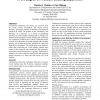104
click to vote
CHI
2000
ACM
15 years 4 months ago
2000
ACM
Haptic devices are now commercially available and thus touch has become a potentially realistic solution to a variety of interaction design challenges. We report on an investigati...
CHI
2000
ACM
15 years 4 months ago
2000
ACM
As online groups grow in number and type, understanding lurking is becoming increasingly important. Recent reports indicate that lurkers make up over 90% of online groups, yet lit...
108
click to vote
CHI
2000
ACM
15 years 4 months ago
2000
ACM
This study examines whether people would interpret and respond to paralinguistic personality cues in computergenerated speech in the same way as they do human speech. Participants...
85
Voted
CHI
2000
ACM
15 years 4 months ago
2000
ACM
We performed several experiments using a Personal Digital Assistant (PDA) as an input device in the nondominant hand along with a mouse in the dominant hand. A PDA is a small hand...
CHI
2000
ACM
15 years 4 months ago
2000
ACM
Coordination definitions and metrics are reviewed from the motor control, biomedical, and human factors literature. This paper presents an alternative measurement called the M-met...
119
click to vote
CHI
2000
ACM
15 years 4 months ago
2000
ACM
Interfaces based on recognition technologies are used extensively in both the commercial and research worlds. But recognizers are still error-prone, and this results in human perf...
CHI
2000
ACM
15 years 4 months ago
2000
ACM
Peripheral information is information that is not central to a person’s current task, but provides the person the opportunity to learn more, to do a better job, or to keep track...
CHI
2000
ACM
15 years 4 months ago
2000
ACM
Discrete and continuous modes of manual control are fundamentally different: buttons select or change state, while handles persistently modulate an analog parameter. User interfac...
90
Voted
CHI
2000
ACM
15 years 4 months ago
2000
ACM
Pen-based user interfaces are becoming ever more popular. Gestures (i.e., marks made with a pen to invoke a command) are a valuable aspect of pen-based UIs, but they also have dra...
111
click to vote
CHI
2000
ACM
15 years 4 months ago
2000
ACM
Through a study of web site design practice, we observed that web site designers design sites at different levels of refinement—site map, storyboard, and individual page— and ...




